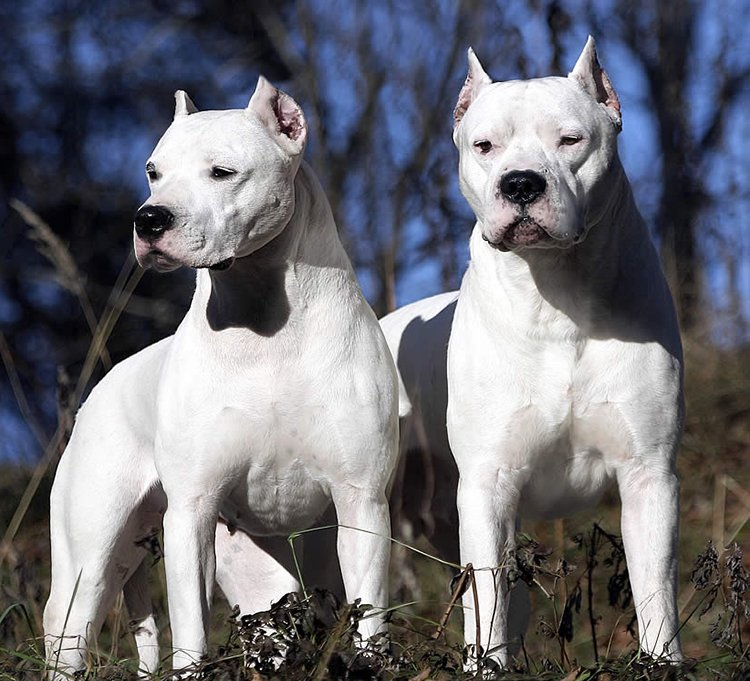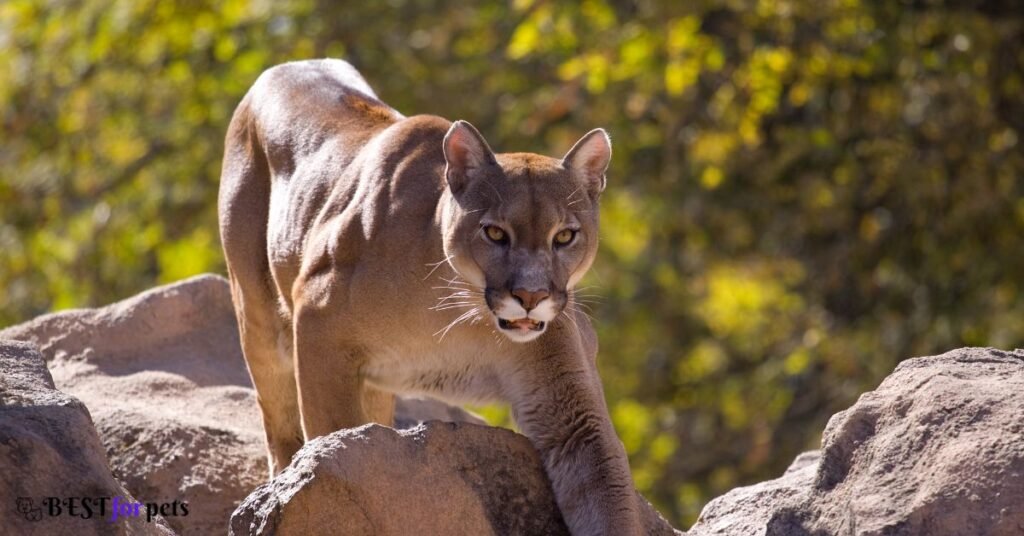Dogo Argentino Vs Puma
Meet the Dogo Argentino:
The Dogo Argentino, also known as the Argentine Mastiff, is a breed developed in the early 20th century by Dr. Antonio Nores Martinez. Their purpose was to create a versatile hunting dog capable of tracking down and confronting large game, including wild boars and mountain lions. With their imposing size, muscular build, and tenacious nature, Dogo Argentinos possess the ideal traits for their designated role.
Physical Characteristics:
Size and Weight:
Adult Dogo Argentinos typically stand 24 to 27 inches tall at the shoulder, with males weighing between 80 to 100 pounds and females slightly smaller.
Muscular Build:
They have a robust, athletic physique, featuring a broad chest, strong legs, and a sturdy neck.
Coat:
Dogo Argentinos have a short, dense white coat that offers protection while hunting and makes them easily visible in the field. Temperament and Trainability:
Fearlessness:
Dogo Argentinos exhibit remarkable bravery and fearlessness when facing challenges, traits that make them effective hunters and protectors.
Loyalty:
They are fiercely loyal and devoted to their families, making them excellent companions and guard dogs.
Trainability:
Dogo Argentinos are highly intelligent and trainable, allowing them to learn commands and tasks with relative ease.


Unveiling the Puma:
The Puma, scientifically known as Puma concolor, also goes by various names such as mountain lion, cougar, or panther. This magnificent feline inhabits a vast range of ecosystems, from mountains to forests, across the Americas.
Physical Characteristics:
Size and Weight:
Pumas are among the largest native felids in the Americas. Males can reach lengths of up to 8 feet, including their tail, and weigh between 115 to 220 pounds.
Agile Build:
Pumas possess a sleek and agile physique, with a long and muscular body built for speed and quick maneuvers.
Camouflaged Coat:
Their fur varies in color, ranging from reddish-brown to gray, allowing them to blend effectively into their surroundings. Behavioral Traits:
Solitary Nature:
Pumas are solitary creatures, preferring to roam their territories alone, except during mating season.
Stealth and Ambush:
They are known for their stealthy approach and remarkable ability to ambush prey, often attacking from behind to secure a successful kill.
Adaptability:
Pumas are highly adaptable, capable of thriving in diverse habitats, including forests, deserts, and mountains.
Clash of the Titans: Dogo Argentino vs Puma
Hunting Strategies:
Dogo Argentino:
Trained in hunting large game, Dogo Argentinos typically work in packs to the corner and subdue their prey. Their role is to immobilize the animal until the hunter arrives.
Puma:
Pumas rely on their solitary nature and stealthy approach to surprise their prey. They utilize their incredible agility and powerful hind legs to leap onto their victims, aiming to deliver a swift and fatal bite to the neck or head.
Strength and Physical Abilities:
Dogo Argentino:
With their muscular build and impressive strength, Dogo Argentinos are capable of taking down formidable opponents. They possess a strong bite force, allowing them to inflict significant damage and immobilize their prey.
Puma:
Pumas, despite being smaller in size compared to some other big cat species, are incredibly powerful and possess remarkable athleticism. They are known for their ability to leap up to 20 feet horizontally and 15 feet vertically, enabling them to outmaneuver and overpower their prey.
Adaptability and Environment: Dogo Argentino vs Puma
Dogo Argentino:
Originally bred to thrive in the diverse landscapes of Argentina, Dogo Argentinos have adapted to various terrains, including forests, mountains, and grasslands. Their physical endurance allows them to navigate through challenging environments during hunts.
Puma:
Pumas are highly adaptable predators that can thrive in a wide range of habitats, including dense forests, rocky terrains, and even deserts. This adaptability gives them an advantage in terms of finding suitable hunting grounds and securing their survival. Instinct and Experience:
Dogo Argentino:
While Dogo Argentinos are primarily trained in hunting dogs, their instincts play a crucial role in their ability to confront and subdue large prey. They possess a natural drive and determination to protect and serve their human companions.
Puma:
Pumas are apex predators with a lifetime of experience hunting and surviving in the wild. Their instincts are finely honed, allowing them to make split-second decisions during encounters, maximizing their chances of success.
The Hypothetical Encounter: Dogo Argentino vs Puma
Given the hypothetical scenario of a Dogo Argentino encountering a Puma, several factors come into play:
Size and Strength:
The Dogo Argentino is larger and more robust than the Puma. Its size and muscular build give it a significant advantage in terms of physical strength.
However, the Puma compensates for its relatively smaller size with agility, quick reflexes, and a more lethal bite force. Hunting Techniques:
Dogo Argentinos are bred to work in packs, which can potentially tip the scales in their favor in a confrontational situation. Their cooperative hunting strategies may allow them to overpower a single Puma.
Pumas, on the other hand, are solitary predators known for their stealth and ambush techniques. Their ability to strike swiftly and effectively could give them an advantage in surprise attacks. Experience and Adaptability:
Pumas, as wild predators, have a lifetime of experience hunting and surviving in their natural environment. This experience provides them with a deep understanding of their prey’s behavior and how to exploit vulnerabilities.
Dogo Argentinos, though trained for hunting, may lack the same level of natural instincts and adaptability as a wild predator.
Dogo Argentino vs Puma: Nutrition
Dogo Argentino Nutrition:
As a large and active breed, Dogo Argentinos require a balanced and nutrient-rich diet to support their muscular build, energy levels, and overall health. Here are some key considerations for their nutrition:
High-Quality Protein:
Protein is crucial for muscle development and repair. Dogo Argentinos benefit from a diet rich in high-quality animal protein sources like lean meats (chicken, beef, fish) and eggs.
Healthy Fats:
Fats provide a concentrated source of energy and contribute to healthy skin and coat. Including moderate amounts of healthy fats from sources like fish oil, flaxseed oil, or chicken fat can be beneficial.
Carbohydrates:
While not a primary energy source for dogs, carbohydrates in the form of whole grains (brown rice, quinoa) and vegetables can provide additional nutrients and dietary fiber.
Essential Vitamins and Minerals:
Dogo Argentinos require a well-rounded supply of vitamins and minerals for optimal health. These can be obtained through a balanced diet or with the guidance of a veterinarian regarding appropriate supplementation.
Hydration:
Access to clean and fresh water is essential for Dogo Argentinos to maintain proper hydration, especially during periods of increased activity and exercise.
It is important to note that individual Dogo Argentinos may have specific dietary needs or sensitivities, and consulting with a veterinarian is recommended to create a tailored nutrition plan for your dog.
Puma Nutrition:
Pumas, as wild carnivores, have specific dietary needs that are met through hunting and consuming a variety of prey animals. Their natural diet consists primarily of ungulates such as deer, elk, and bighorn sheep. Here are some key aspects of Puma nutrition:
Carnivorous Diet:
Pumas are obligate carnivores, meaning their diet is predominantly meat-based. Their bodies are adapted to efficiently digest and utilize animal protein as their primary energy source.
Fresh and Whole Prey:
In the wild, Pumas consume their prey in its entirety, including muscle meat, organs, bones, and sometimes even fur. This ensures they obtain a wide range of nutrients and essential fatty acids.
Balanced Diet:
Pumas have evolved to benefit from a balanced prey diet, where they receive a variety of nutrients and vitamins from different animal species they consume.
Hydration:
Pumas obtain most of their water requirements from the moisture content of their prey. They have a low thirst drive and are adapted to survive in arid environments.

Frequently Asked Questions
Can a Dogo Argentino kill a puma?
While Dogo Argentinos are powerful hunting dogs, a direct confrontation between a Dogo Argentino and a full-grown Puma can be extremely dangerous for both animals. The outcome of such an encounter is unpredictable and highly dependent on various factors, including the size, experience, and circumstances of the encounter. It is important to prioritize the safety and well-being of both species and avoid situations that could lead to such conflicts.
Are Dogo Argentinos used to hunt pumas?
Dogo Argentinos were originally bred to hunt large game, including wild boars and mountain lions (which are also known as pumas). However, it is important to note that hunting practices involving pumas are regulated and restricted in many regions. In most areas, hunting pumas with dogs is illegal to protect the conservation and welfare of these big cats.
Can a Dogo Argentino be trained to protect against pumas?
Dogo Argentinos can be trained as protection dogs and can provide a deterrent against various threats. However, it is important to understand that pumas are wild predators and possess unique instincts and capabilities. While a Dogo Argentino may offer protection, it is essential to prioritize human safety and avoid situations where conflicts with wild predators can arise.
Are Dogo Argentinos and pumas compatible as pets?
Dogo Argentinos can make loyal and loving family pets when properly trained, socialized, and given appropriate care. However, pumas are wild animals and not suitable as pets. They require specific environments, specialized care, and legal permits to ensure their welfare and the safety of humans.
Are there any natural habitats where Dogo Argentinos and pumas coexist?
Dogo Argentinos are primarily domesticated dogs and are not typically found in the wild. Pumas, on the other hand, have a wide range across the Americas, including various habitats such as forests, mountains, and grasslands. While there might be overlapping regions where both species are present, it is important to remember that pumas are wild animals, and interactions between them and domesticated dogs should be avoided to ensure the safety of both animals.
How do pumas typically react to the presence of dogs?
Pumas, being solitary and territorial predators, generally try to avoid confrontations with other animals, including dogs. In the presence of dogs, pumas usually prefer to retreat and avoid conflict. However, if a puma feels threatened or cornered, it may become defensive and potentially attack in self-defense. It is crucial to keep dogs under control and prevent them from approaching or provoking wild animals to minimize any potential conflicts.
Are there any conservation efforts in place to protect pumas and their habitats?
Yes, there are numerous conservation efforts focused on protecting pumas and their habitats. These initiatives aim to preserve biodiversity, manage human-wildlife conflicts, and ensure the long-term survival of puma populations. Conservation organizations work on habitat preservation, research, public awareness campaigns, and implementing measures to minimize human impact on puma habitats. Additionally, regulations and legislation are in place in many regions to safeguard the welfare and conservation of pumas.

